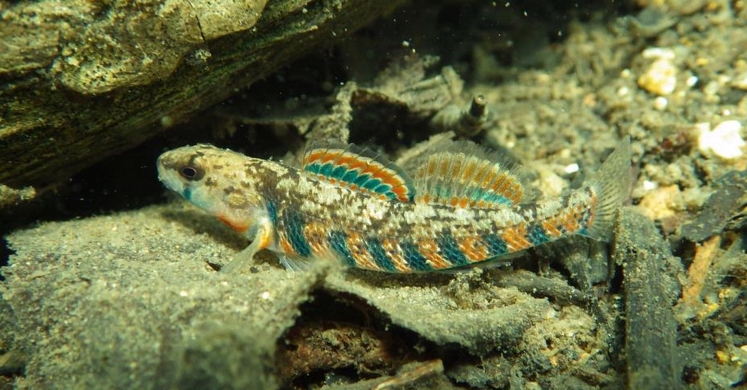Blog

#bioPGH Blog: Ecology Lessons from Pennsylvania Darters
 A resource of Biophilia: Pittsburgh, #bioPGH is a weekly blog and social media series that aims to encourage both children and adults to reconnect with nature and enjoy what each of our distinctive seasons has to offer.
A resource of Biophilia: Pittsburgh, #bioPGH is a weekly blog and social media series that aims to encourage both children and adults to reconnect with nature and enjoy what each of our distinctive seasons has to offer.
If you’ve never seen the aptly named rainbow darter, one of our native Pennsylvania fishes, you’re missing a stunning sight! Like many other species of darter, male rainbow darters are bright and colorful during the mating season, but they return to a more camouflaged motif the rest of the year.
Rainbow darters and their related fishes are intriguing on their own, but they are also a great example of ecological principles. A high quality stream may be home to several darter species, all of which may be roughly similar in size (around 2-6 inches long). Have you ever wondered, though, how they manage to all find enough food and space? An important ecological concept called Gause’s Law of Competitive Exclusion states that two species using the same resources in an environment cannot coexist over time—the two species would either deplete their resources or one species would outcompete the other. So what are a bunch of similar, smaller fishes living in the same area to do? Some types of darters may indeed compete for their dinners, but darters are a great example of what is called “resource partitioning.” What is that, you ask? Let’s explore!
Pennsylvania is home to twenty-one darter species in different river drainage systems throughout the state, and nearly all of the species can be found somewhere within the drainage basin of the Ohio River. Our Pennsylvania species are all relatively small fishes from either the genus Etheostoma or Percina, ranging in size from about two inches long to a little over six inches long. Most species are bottom-dwelling foragers, staying low in riffles (shallow, rocky areas with quick moving water) to avoid predators and feed on invertebrates, but a few will live a little above stream bottoms and in calmer water. Males of many darter species develop extraordinary coloration patterns during the breeding season to attract females. Darter breeding seasons can last from early spring until late summer, with some species laying eggs multiple times per breeding season.
Considering that darter species have quite a fair bit in common (similar habitat, similar diet, similar breeding times), they exhibit resource partitioning. In ecological terms, a “resource” is anything that an organism needs for daily survival: food, space, shelter, etc. Thus, resource partitioning describes how different species have adapted to using similar resources, just in different ways. Take food resources, for example. Darters may feast on invertebrates, but different species—and sometimes even different sexes within a species—will specialize on different sizes of invertebrates. For example, rainbow darters and Tippecanoe darters tend to favor prey that are 6 mm in length or shorter, whereas the spotted darter may eat prey items up 13 mm long. Not surprisingly, darters are less likely to follow this trend of diet items when resources are abundant, but they are more likely to feed on “their favorite” size prey when resources become scarce.
Resource partitioning is exceptionally important in nature. It often leads to adaptations in different species as they specialize on a particular resource over the course of many generations. Our Pennsylvania darters are one example of differential resource use, but it can be found throughout the wild world. Keep exploring!
Pennsylvania Darters
Banded Darter
Blackside Darter
Bluebreast Darter
Channel Darter
Eastern Sand Darter
Fantail Darter
Gilt Darter
Greenside Darter
Iowa Darter
Johnny Darter
Logperch
Longhead Darter
Rainbow Darter
River Darter
Sharpnose Darter*
Shield Darter
Spotted Darter
Swamp Darter*
Tessellated Darter
Tippecanoe Darter
Variegate Darter
An * indicates the species is most likely extirpated from the state
Connecting to the Outdoors Tip: The next time you walk by a riffle in a stream, take note of the unique habitat type created by the bouncing water as it splashes over the small rocks. That is perfect habitat for a number of our PA darters, but they also need clear, clean water. Check out this interactive lesson plan from the EPA to explore ways that we can all help keep our waterways clean.
Continue the Conversation: Share your nature discoveries with our community by posting to Twitter and Instagram with hashtag #bioPGH, and R.S.V.P. to attend our next Biophilia: Pittsburgh meeting.
Resources
PA Fish and Boat Commission: Pennsylvania’s Dynamic Darters
French Creek Conservancy: The Darters of French Creek
Gray et al. 1997- Food Resource Partitioning by Nine Sympatric Darter Species
Nature—Resource Partitioning and Why it Matters
Photo Credit: USFWS and Pexel CC0
